Targets
Overview
Sugar's Targets module consists of individual people who are unqualified prospects that you have some information on but who are not yet qualified leads. Information (e.g., name, email address) regarding these targets are normally acquired from business cards you receive while attending various trades shows, conferences, etc. Targets in Sugar are stand-alone records as they are not related to contacts, leads, accounts, or opportunities. Once the target is qualified according to your organization's practices, it can be converted into a lead record.
This documentation will cover information and actions specific to the Targets module. For instructions concerning views and actions that are common across most Sugar modules, such as creating, editing, and deleting targets, please refer to the Working With Sugar Modules section of this page.
Please note that you will only be able to see target records as allowed by your team membership, user access type, and assigned roles. For more information on teams and roles, please refer to the Team Management and Role Management documentation in the Administration Guide.
Note: The Targets module is not available for Sugar Serve users. For more information on license types and the functionality available for each, refer to the License Types Matrix documentation.
Target Fields
The Targets module contains a number of stock fields that come out-of-the-box with Sugar. For information on using and editing various field types, refer to the User Interface documentation. The definitions below are suggested meanings for the fields, but the fields can be leveraged differently to best meet your organization's needs. Administrators or users with developer-level role access have the ability to alter, add, or remove fields via Admin > Studio. For more information on configuring fields, please refer to the Studio documentation in the Administration Guide.
| Field | Description |
| Account Name | The account to which the target belongs. |
| Alternate Address | The target's alternate address (e.g., billing or shipping). |
| Assigned To | The Sugar user assigned to the target. |
| Assistant | The name of the target's assistant within his or her company. |
| Assistant Phone | The assistant's phone number. If an admin has turned on the Enable Click-to-Call setting in Admin > System Settings, phone number fields are displayed as links that can be opened to dial them using the default computer telephony integration software on the user's computer. |
| Birthdate | The target's date of birth. |
| Comment Log | A shared log of messages, comments, or other text, including the name of the user that added the log entry and the date and time it was added. It is possible to tag other users and link to other Sugar records in Comment Log entries by inserting a clickable pill; see the User Interface documentation for more details. |
| D&B Principal ID | Unique ID number associated to the individual in D&B. |
| Date Created | The date the target record was created. |
| Date Modified | The date the target record was last modified. |
| Department | The target's department within their company. |
| Description | A description or other information about the target. |
| Do Not Call | Indication that the target should not be called. |
| Email Address | The target's email address. |
| Email Opt Out | Indication that the target has opted out of receiving emails. |
| Facebook Account | The target's Facebook account information. |
| Fax | The target's fax number. |
| First Name | The target's first name. |
| Google Plus ID | The target's Google Plus ID. |
| Home | The target's residence number. If an admin has turned on the Enable Click-to-Call setting in Admin > System Settings, phone number fields are displayed as links that can be opened to dial them using the default computer telephony integration software on the user's computer. |
| Integration Sync ID | The sync key field used by external integrations to identify Sugar records in the external application. See the Integrate REST API endpoints in the Developer Guide for more details on how to use this field. |
| Last Name | The target's last name. |
| Mobile | The target's mobile number. If an admin has turned on the Enable Click-to-Call setting in Admin > System Settings, phone number fields are displayed as links that can be opened to dial them using the default computer telephony integration software on the user's computer. |
| Name | When viewing, the target's full name. |
| Office Phone | The target's office number. If an admin has turned on the Enable Click-to-Call setting in Admin > System Settings, phone number fields are displayed as links that can be opened to dial them using the default computer telephony integration software on the user's computer. |
| Other Phone | The target's alternate phone number. If an admin has turned on the Enable Click-to-Call setting in Admin > System Settings, phone number fields are displayed as links that can be opened to dial them using the default computer telephony integration software on the user's computer. |
| Primary Address | The target's primary address. |
| Salutation | Standard greeting for the target (e.g., Mr., Ms., Mrs., etc.). |
| Tags | User-created keywords that can be used to identify records in filters, dashlets, and reports. Note: For more information on creating and using tags, please refer to the Tags documentation. |
| Teams | The Sugar team(s) assigned to the target record. |
| Title | The target's business title. |
| Twitter Account | The target's Twitter account information. |
Converting Targets to Leads
Sugar enables you to convert targets to leads as you determine they qualify for your organization's definition of a lead (e.g., after an evaluation/qualification process) and becomes a valid sales prospect. Please note that targets are only converted into leads in Sugar, and the new lead record will have a relationship to the original target record. Once the lead is qualified as a sales opportunity, they can be converted into contacts, opportunities, and accounts. For more information on lead conversions, please refer to the Leads documentation.
Use the following steps to convert a qualified target to a lead:
- Navigate to a target's record view.
- Select "Convert Target" from the Actions menu.

- Enter appropriate values for the fields in the Leads record view layout then click "Save".
- Since targets only convert to a lead, the Leads record view displays all lead fields that are grouped by default into the Overview, More Information, and Other panels. Administrators have the ability to determine what fields are displayed on the Leads record view via Admin > Studio. For more information on configuring layouts, please refer to the Studio documentation in the Administration Guide.
- Once the conversion is complete, the target record will display the converted lead name at the top of the record view page. You can click the record's name to view the detail of the converted lead.

Emails and Targets
Targets include an email address that can be used to email the target as a recipient. The methods for doing so are covered in the Emailing Records section of the User Interface documentation. Targets may also be recipients of campaigns that allow you to send email messages to a large group of recipients as well as to track the results of that message. Please refer to the Campaigns and Targets section of this page for more information. In addition to being a recipient or sender of an email, targets may be related to emails by being selected in the email's Related To field. These relationships allow the target to display all relevant email correspondence in the Emails subpanel and History dashlet on a target's record view.
Emails Subpanel
The Emails subpanel under the Targets record displays emails that are related to the target record in a variety of ways:
- Explicitly related to the target: If the target is selected in the email's Related To field, the email and target are explicitly related, and the email will appear in the target's Emails subpanel and History dashlet. Instructions for using this flex relate field are available in the Emails documentation.
- Implicitly related to the target: If one of the target's email addresses appears in the email's From, To, or Cc fields, the email and target are implicitly related, and the email will appear in the target's Emails subpanel and History dashlet. This implicit relationship is made for emails sent from Sugar as well as any email imported into Sugar via Inbound email targets or email archiving.
For more information on working with records in subpanels, refer to the User Interface documentation.
Campaigns and Targets
Sugar's Campaigns module can be used to send mass emails or a series of newsletter emails to Sugar accounts, contacts, leads, and targets. The results of each campaign are recorded to measure its impact. Targets are not related directly to campaigns. Rather, each campaign is related to several target list records, and each target list is related to targets and other recipients. To send a campaign email to a target, the target should belong to a default-type target list related to the campaign. To prevent a target from receiving emails from a campaign, the target should belong to the campaign's suppression list-type target list. Once a campaign is sent, the results specific to a particular target will appear in the Campaign Log Subpanel on the target's record view as described in the Campaign Log Subpanel section of this page.
Targets can be added to target lists via the target list record itself, from the Targets list view using the Add To Target List option, or from the Targets record view using the Manage Subscriptions option. Instructions for using the Add To Target List and Manage Subscriptions options in the Targets module are provided in the sections below. For instructions on other available methods of adding to target lists, please refer to the Target Lists documentation.
Adding to a Target List via Targets List View
A target list consists of a group of individuals or organizations to be included or excluded from a mass marketing campaign. These targets are typically identified based on a set of predetermined criteria such as being a prospect or existing customer, age group, industry, etc. There are various ways to add targets to a target list in Sugar including using the Add To Target List option from the Target list view's Mass Actions Menu. For more information on target lists and other methods of adding target, please refer to the Target Lists documentation.
You can use the Select All feature in the list view when adding to a target list, which will allow you to easily select the first 1000 records in the result set. To add more than 1000 records or add a specific group of records to the target list, please use the filter option in list view search to perform the additions in smaller batches.
Use the following steps to add targets to a target list via the Targets list view:
- Navigate to the Targets list view by clicking the Targets module tab.
- Use the List View Search to find the Target records to add to a target list.
- Select the desired target records then choose "Add to Target List" from the Mass Actions menu.
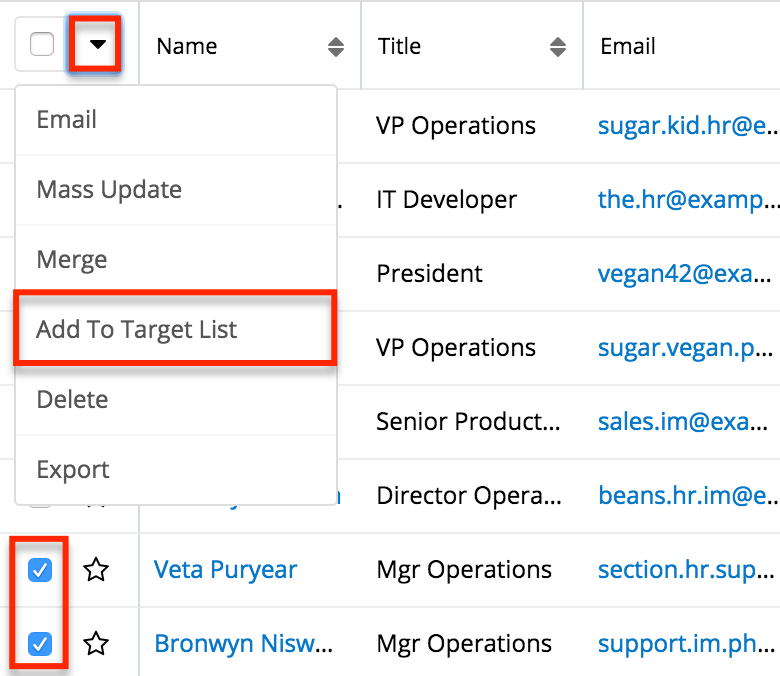
- Below the search bar, locate and select the desired target list in the dropdown list or click "Create new target list" to add the targets to a new target list. Click "Update" to add the record(s) to the target list.
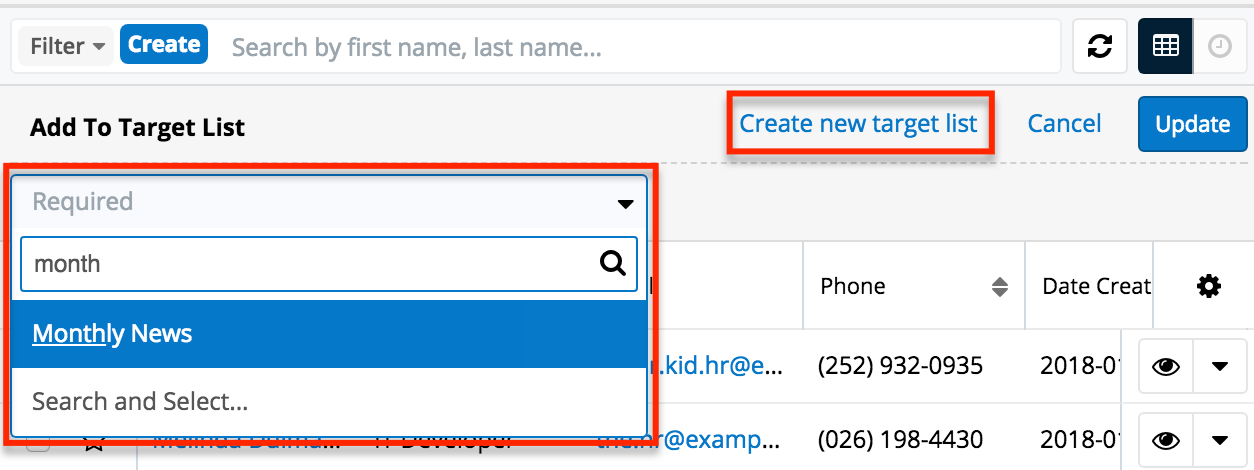
In order to view the targets that have been added, you can navigate to the Target Lists module. Click the target list's name to open the record view, and you will see the target records within the Targets subpanel. 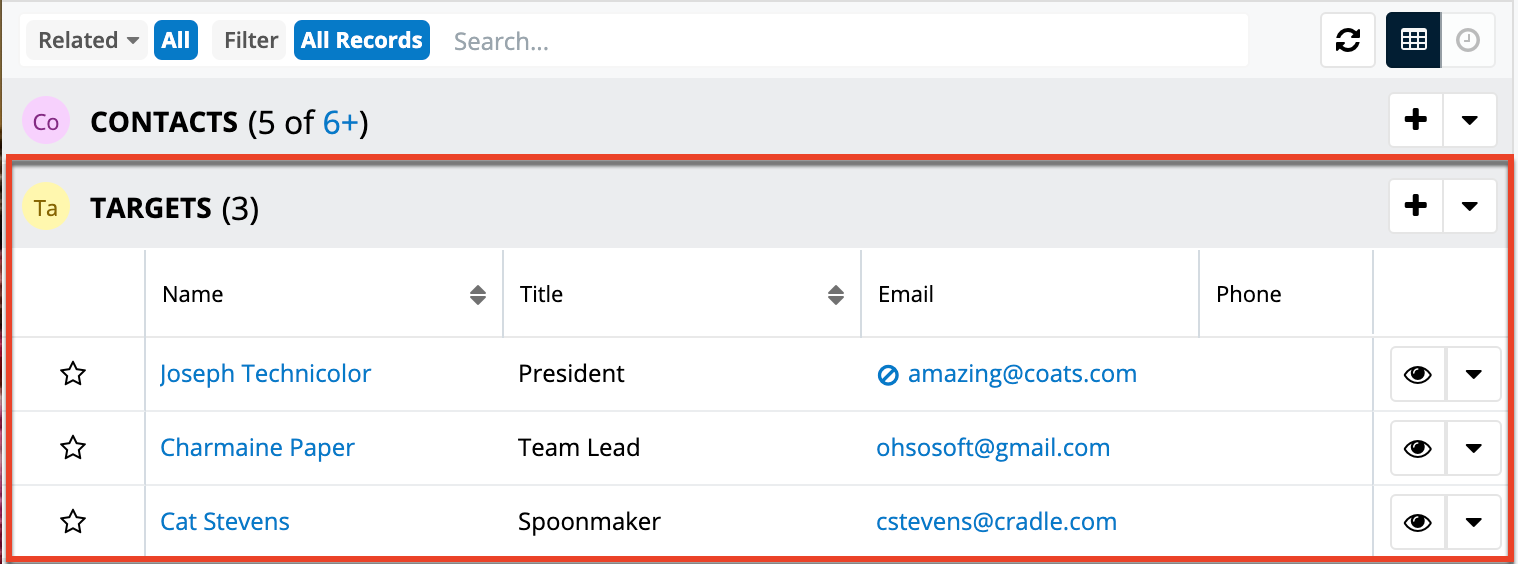
For more information on working with records in subpanels, refer to the User Interface documentation.
Managing Target Subscriptions
Targets who receive newsletter-type campaign emails from your Sugar instance are considered subscribers to that newsletter. Users can manage these newsletter subscriptions from a target's record view using the Manage Subscriptions option in the Actions menu. Please note that you can only manage subscriptions for newsletter-type campaigns. A newsletter campaign you have created will have one or more default-type target lists. Targets are added to these target lists in order to receive your newsletter. The Manage Subscriptions option allows you to add a target to the default-type or suppression-type target lists of your newsletter campaigns without leaving the Targets module. For more information on newsletter subscriptions, please refer to the Campaigns documentation.
Use the following steps to manage target subscriptions via a target's record view:
- Navigate to a target record's record view.
- Select "Manage Subscriptions" from the Actions menu.
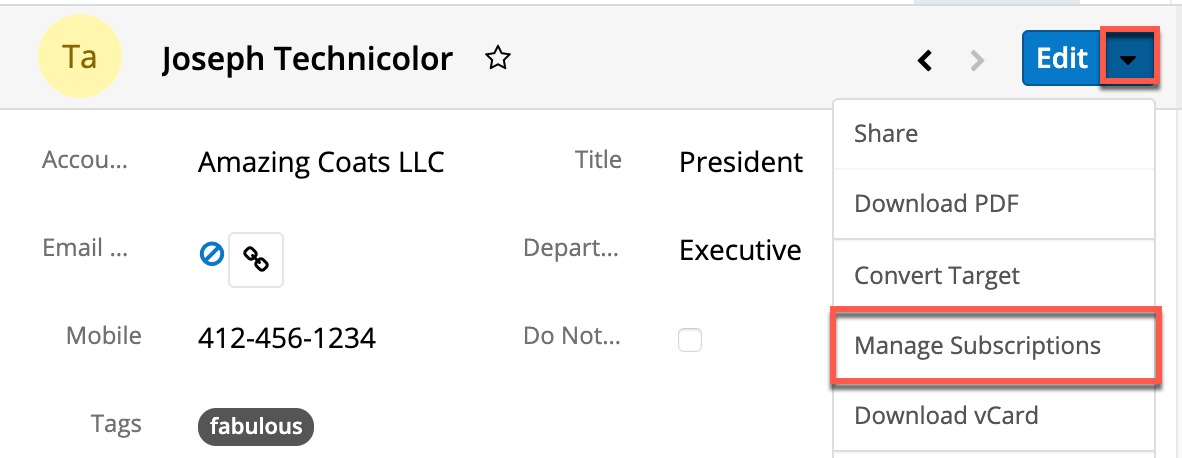
- To add the target to a newsletter subscription mailing list, select the newsletter from the Available/Newsletters Unsubscribed To list and drag it to the Newsletters Subscribed To list. This will add the target to the campaign's default target list.
- To remove the target from the newsletter subscription mailing list, select the newsletter from the Newsletters Subscribed To list and drag it to the Available/Newsletters Unsubscribed To list. This will add them to the suppression-type unsubscription target list for the newsletter campaign, which will prevent the target from receiving the newsletter. Please note that the target will not be removed from the campaign's default target list.
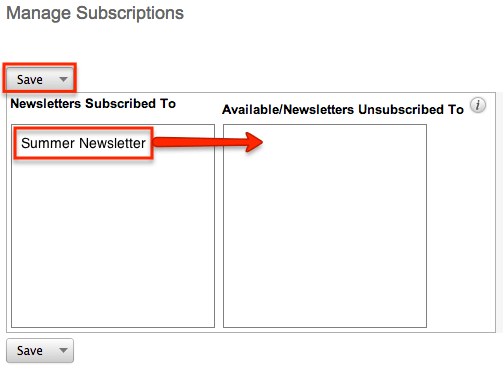
- Click "Save" to preserve your changes.
Campaign Log Subpanel
The Campaign Log subpanel contains historical information regarding a target's interaction with all Sugar campaigns. When a mass marketing campaign is sent to a target (or manually marked as sent in the case of non-email campaigns), the related campaign activity information will appear within the Campaign Log subpanel on the target's record view. This information mirrors the "View Status" page available from within each individual campaign and shows activities such as when a campaign was sent, when the recipient viewed the campaign message, when the recipient clicked a tracked link within the campaign, etc. Since this subpanel contains historical campaign interactions for the target, it cannot be used to associate a target with a campaign or otherwise manage a campaign or target list. For more information on associating a target with a campaign, please refer to the Adding to a Target List via Targets List View section of this page. For more information on campaigns, please refer to the Campaigns documentation.
For more information on working with records in subpanels, refer to the User Interface documentation.
vCards and Targets
vCards are electronic business cards that are exchanged between applications such as email and web browsers. Targets may be created from vCards generated by another application or saved as vCards for use in other software.
Creating Targets via vCard
Use the following steps to create a target in Sugar via vCard:
- Click the three-dots menu in the Targets module tab and select "Create Target From vCard".
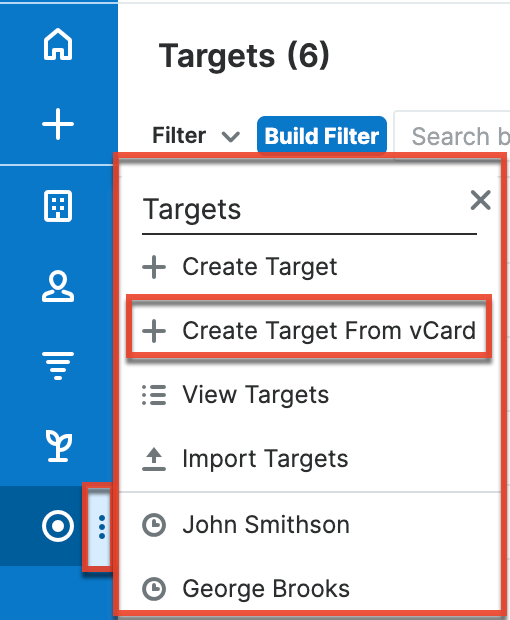
- Choose the vCard file from your computer and click "Create".

Downloading a Target's vCard
The following steps cover downloading a vCard and saving it as a target in Microsoft Outlook as an example:
- Navigate to a Targets record view.
- Select "Download vCard" from the Actions menu to download the vCard file.
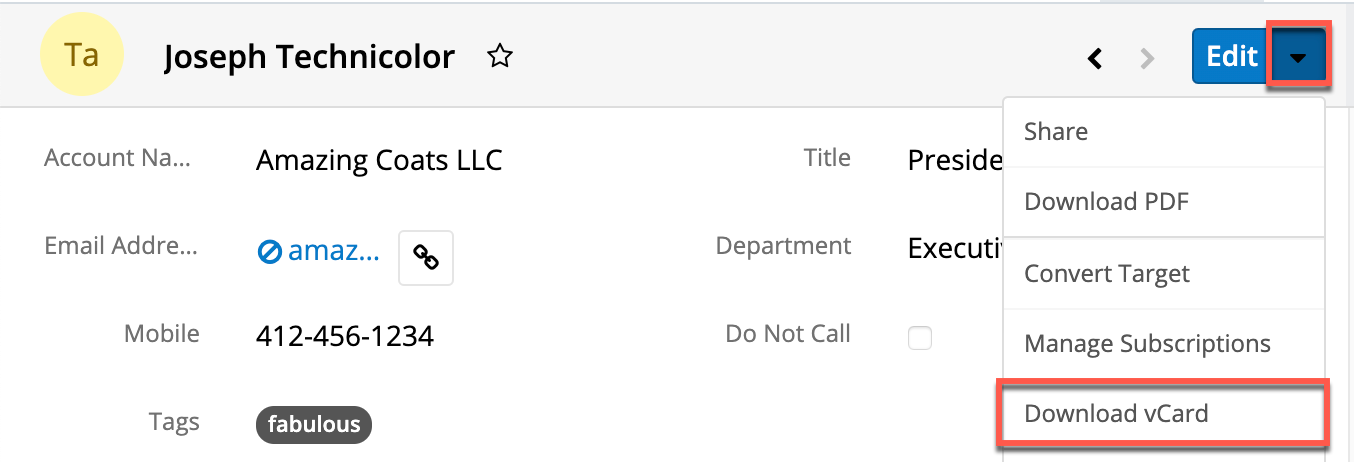
- Open the downloaded file in your mail or address book application. For this example, double-clicking opens the vCard in Outlook.
- Make any necessary changes to the information, then click "Save & Close" to save this lead in Outlook.
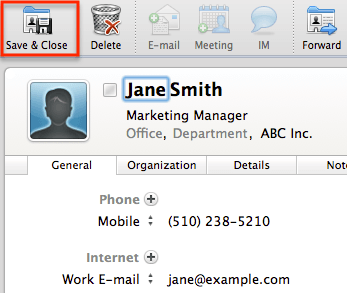
Working With Sugar Modules
The Targets module uses Sugar's Sidecar user interface. The following sections detail menus, views, and actions common to Sidecar modules and contain links to additional information within the page or links to the User Interface documentation.
Target Menus
The Targets module contains various options and functionality that are available via menus in the module tab, list view, and record view. The following sections present each menu and its options with a link to more information about the menu option either in the User Interface documentation or, for Targets-specific functionality, within this page.
Module Tab Menus
Click the Targets module tab in the navigation bar to access the Targets list view. You may also click the three-dots menu in the Targets module tab to display the Actions, Recently Viewed, and Favorites menus. The Actions menu allows you to perform important operations within the module. The Recently Viewed menu displays the list of targets you most recently viewed. The Favorites menu displays the list of targets you most recently marked as favorites.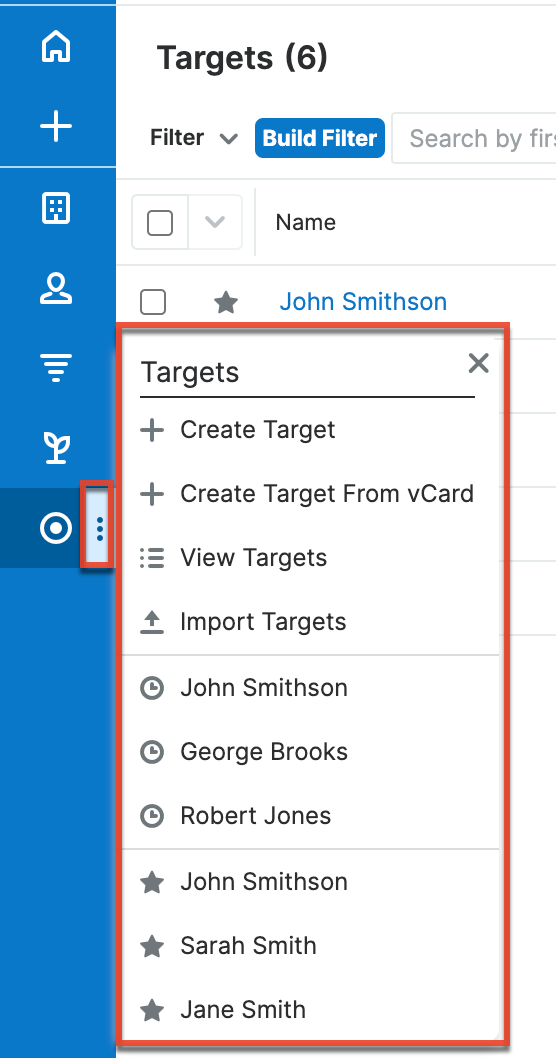
The module tab's Actions menu allows you to perform the following operations:
| Menu Item | Description |
| Create Target | Opens the record view layout to create a new target. |
| Create Target From vCard | Opens the record view layout and populates fields from a vCard. |
| View Targets | Opens the list view layout to search and display targets. |
| Import Targets | Opens the import wizard to create or update targets using external data. |
For more information on module tab menus including reasons a module may not be included in the menu, see the User Interface documentation.
List View Menus
The Targets list view displays all target records and allows for searching and filtering to locate specific targets. You can view the basic details of each record within the field columns of the list view or click a target's name to open the record view. To access a module's list view, simply click the module's tab in the navigation bar.
List View Mass Actions Menu
The Mass Actions menu to the right of the checkbox option in the list header allows you to perform mass actions on all currently selected records. You can use the checkbox on each record's row to select individual target records or click the checkbox in the list header to select all records displayed in the current set of list view results.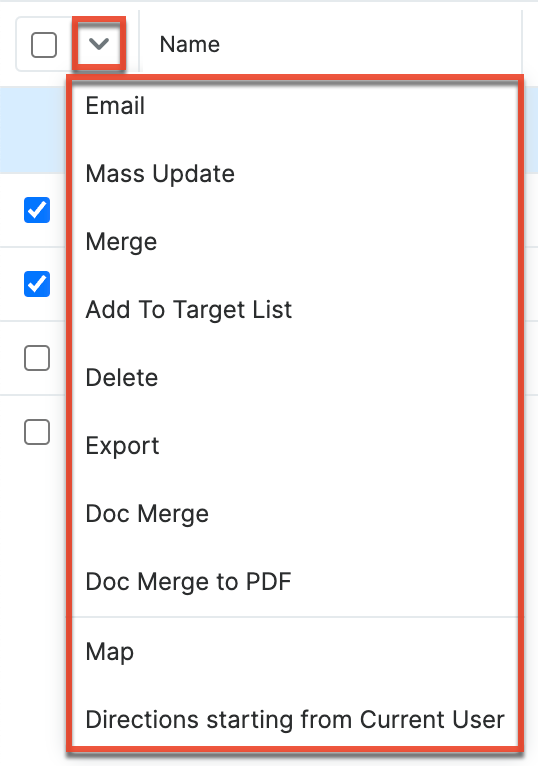
The Mass Actions menu allows you to perform the following operations:
| Menu Item | Description |
| Email one or more targets at a time. | |
| Mass Update | Mass update one or more targets at a time. |
| Merge | Merge two or more duplicate targets. |
| Add to Target List | Add one or more targets to a target list. |
| Delete | Delete one or more targets at a time. |
| Export | Export one or more targets to a CSV file. |
| Recalculate Values | Visible only if the module contains fields using Sugar Logic and only to System Administrators or users with Developer-level role access, this option will refresh the selected records' calculated values. |
| Doc Merge | Select or create a DOCX, XLSX, or PPTX template to merge record data into documents that will be accessible in the Doc Merge widget. |
| Doc Merge to PDF | Select or create a DOCX, XLSX, or PPTX template to merge record data into PDF documents that will be accessible in the Doc Merge widget. |
| Map | For instances with Sugar Maps enabled, display this record or the selected records on a map. |
| Directions starting from Current User | For instances with Sugar Maps enabled, plot driving directions on a map from your address to this record or all selected records. |
List View Record Actions Menu
The Record Actions menu to the far right of each record's row allows you to perform actions on the individual target directly from the list view.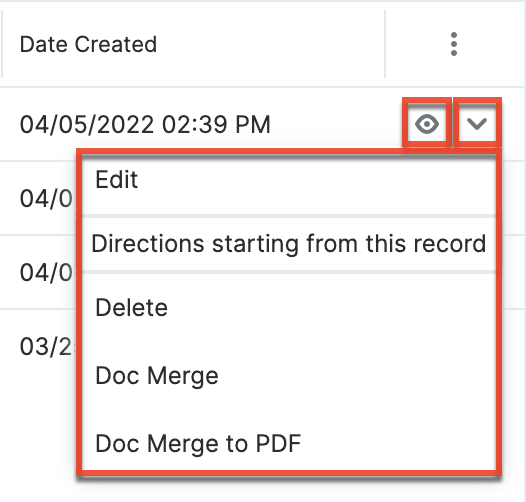
The list view's Record Actions menu allows you to perform the following operations:
| Menu Item | Description |
| Preview (Eye icon) | Preview this target in the intelligence pane. |
| Edit | Edit this target. |
| Directions starting from this record | For instances with Sugar Maps enabled, plot driving directions on a map from this record to another record or records. |
| Delete | Delete this target. |
| Doc Merge | Select or create a DOCX, XLSX, or PPTX template to merge record data into documents that will be accessible in the Doc Merge widget. |
| Doc Merge to PDF | Select or create a DOCX, XLSX, or PPTX template to merge record data into PDF documents that will be accessible in the Doc Merge widget. |
Record View Actions Menu
The Targets record view displays a single target's fields and subpanels of related records. To access a target's record view, simply click a hyperlinked target name from anywhere within Sugar. The record view's Actions menu appears on the top right of the page and allows you to perform various operations on the current record.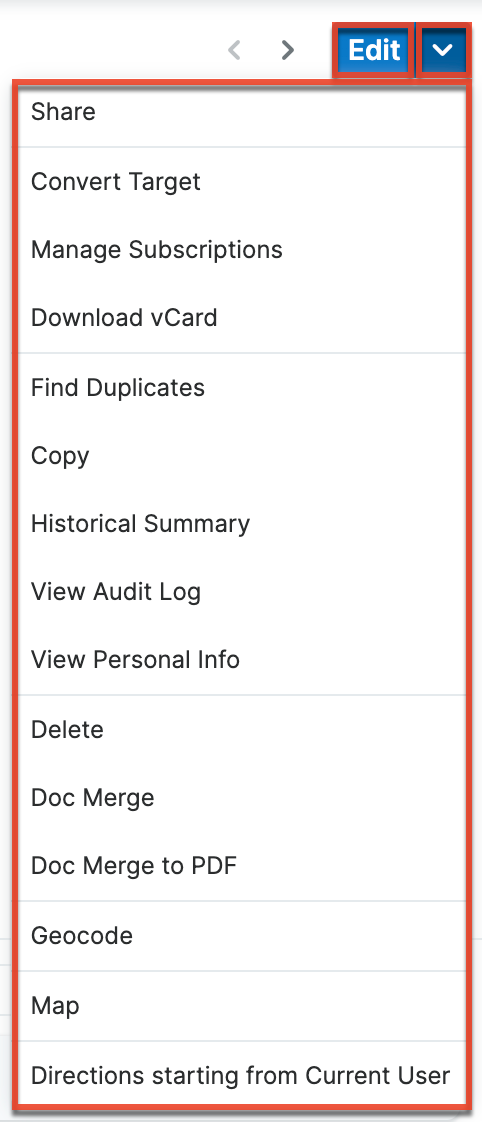
The Actions menu allows you to perform the following operations:
| Menu Item | Description |
| Edit | Edit this target record. |
| Share | Share a link to this target record via email. |
| Download PDF |
Download the target information as a PDF file.
|
| Email PDF |
Email the target information as a PDF attachment.
Note: To send emails through Sugar, users must first configure a default user email account via Emails > Email Settings. |
| Convert Target | Convert this target to a lead. |
| Manage Subscriptions | Manage this target's newsletter campaign subscriptions. |
| Download vCard | Download a vCard from Sugar and transfer this target's information to another application (e.g., Outlook). |
| Find Duplicates | Locate potential duplicates of this target record. |
| Copy | Duplicate this target's information to create a new target record. |
| Historical Summary | View a historical summary of activities (e.g., calls, meetings, etc.) related to this target. |
| View Audit Log | View a record of changes to this target. |
| View Personal Info | Display this record's fields that an admin has designated as personal information. |
| Delete | Delete this target record. |
| Doc Merge | Select or create a DOCX, XLSX, or PPTX template to merge record data into documents that will be accessible in the Doc Merge widget. |
| Doc Merge to PDF | Select or create a DOCX, XLSX, or PPTX template to merge record data into PDF documents that will be accessible in the Doc Merge widget. |
| Geocode | For instances with Sugar Maps enabled, manually set this record's location on a map. |
| Map | For instances with Sugar Maps enabled, display this record or the selected records on a map. |
| Directions starting from Current User | For instances with Sugar Maps enabled, plot driving directions on a map from your address to this record or all selected records. |
Common Views and Actions
In the table below, the left column contains links to the User Interface page covering topics that are applicable to all Sidecar modules. The right column has links to sections of the current page that cover topics specific to targets.
| General Instructions for Working With Sugar Modules | Targets-Specific Instructions |
| Use the links below to navigate to the User Interface page which covers topics generic to many Sugar modules. | When Targets-specific help exists for each topic, use the links below to navigate to sections of the current page. |
| Creating Records | |
| Viewing Records | |
| Searching for Records | |
| List View | List View Mass Actions Menu List View Record Actions Menu |
| Tile View | |
| Record View | Record View Actions Menu |
| Intelligence Pane | |
| Editing Records | |
| Deleting Records | |
| Emailing Records | |
| Exporting Records | |
| Recalculating Calculated Values | |
| Finding Duplicate Records | |
| Merging Records | |
| Viewing Record Historical Summaries | |
| Viewing Record Audit Logs | |
| Record PDFs | |
| Favoriting Records | |
| Following Records | |
| Sharing Records |